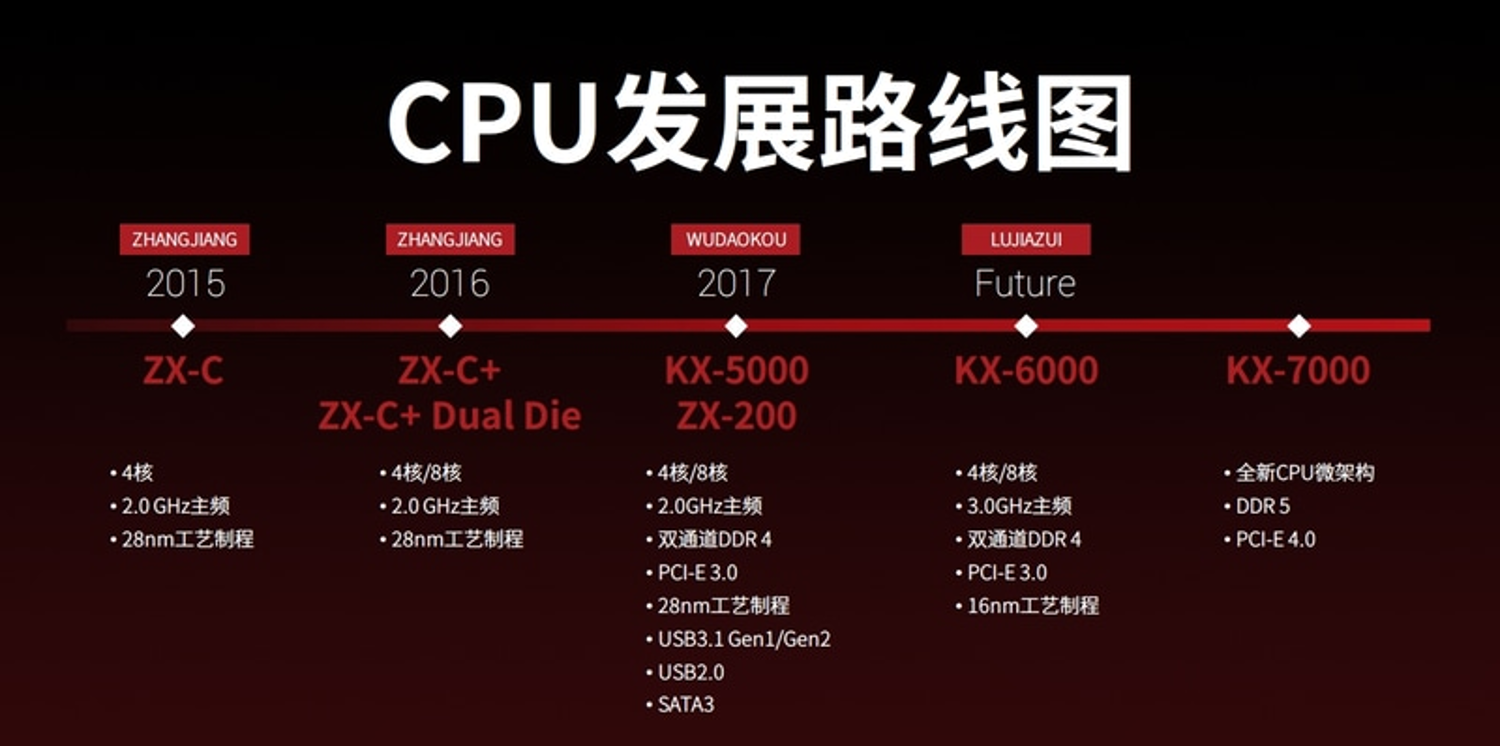Zhaoxin KaiXian x86 CPU Tested: The Rise of China's Chips
Taking on the x86 duopoly
China-based Zhaoxin Semiconductor, which roughly translates to 'million core,' has fielded a new eight-core KaiXian KX-U6780A processor based on its mysterious LuJiaZui microarchitecture and fabbed on TSMC's 16nm FinFET process. Chips based on the architecture bring a new level of performance to China's roster of homegrown chips that span from desktop PCs to servers, but the KX-6000 series is destined for gaming rigs, PCs, and office machines. Today we have the chip in for testing on Zhaoxin's HX002EH1 demo board to determine if it can rank among our list of best gaming CPUs.
Zhaoxin definitely isn't a household name, but it's one of the very few companies that designs bespoke x86 processors. That means it competes with the likes of dominant chip producers AMD and Intel, which is surprising given the patent-protected x86 instruction set and strict licensing agreements that have long narrowed the field of x86 chip producers to the Intel, AMD, and VIA triumvirate. Details are scarce, but the fabless Zhaoxin consists of a joint venture between the Shanghai Municipal Government, which invested 80% of the company's initial capital, and Taiwanese VIA Technologies, which provided 20%. This partnership structure purportedly allows Chinese government-controlled interests to design x86 processors while staying within the legal boundaries of licensing agreements.
The end result is a processor designed specifically for the China market that Zhaoxin says reaches the same level of performance as Intel's seventh-gen Core i5-7400. While that's certainly not overly impressive given that Intel's seventh-gen processors debuted in early 2017, it marks a big step forward for Zhaoxin, which claims its new LuJiaZui microarchitecture provides a 1.5X improvement in instructions per cycle (IPC) throughput over the preceding WuDaoKou architecture. It also comes with several new features, like Zhaoxin's first integrated graphics engine. The KX-6000 line is a step towards a larger goal: It serves as the intermediary processor before the company's next-gen 7nm chips that will come with DDR5 memory and the PCIe 4.0 interface as the company aims for process parity with the incumbents in 2021.
But disrupting the existing duopoly is no easy task. Let's take a quick look at what we know about the Zhaoxin KX-6000 series, then dive into our test results.
The Road to China-Designed Chips
China is by far the world's largest importer of processors, the majority of which are exported as finished products. However, the country has long sought independence from western influences on its economy. China only produces roughly 16% of the silicon it uses in-country, and only half of that production is controlled by Chinese interests. As such, China's reliance on western CPU production presents a strategic liability for the country's economy in the event of a blockade or tariffs, not to mention the implications of potentially nefarious backdoors built into the chips. It's also no secret that today's wars are won with the high-powered chips found in everything from fighter jets to battleships and submarines.
As such, China began an initiative to build its own processors back in the early 80's that eventually evolved into the "Made in China 2025" campaign that has the goal of producing 70% of the chips used in China by 2025. This initiative began long before the U.S.-China trade war unfolded, and the U.S. has long blocked China's attempts at gaining the know-how and equipment to fabricate chips through acquisitions and mergers, a situation that has only intensified recently. Chinese foundry SMIC and others continue to advance, but those foundry's will need solid chip designs when, and if, they can jump to leading-edge nodes.
Undeterred by numerous blocked acquisitions and an inability to buy key tooling for its own fabs, China spread its tentacles to several public/private partnerships to foster indigenous designs. In 2016, AMD forged a partnership with Hygon, a company funded by China-controlled interests, to produce Dyhana processors based on AMD's Zen architecture. The resulting THATIC joint venture was eventually blacklisted by the U.S. in the name of national security as the trade war unfolded.
Get Tom's Hardware's best news and in-depth reviews, straight to your inbox.
Fueled by government investments and preferential treatment in the market, other native Chinese companies have joined the fray, but with non-x86 architectures. Huawei has developed the Kunpeng 920 Armv8 processors for its line of motherboards for desktop PC OEMs and Phytium Technologies is shipping ARM chips. That's important given the rise of Windows on ARM, and Chinese company Loongson also continues to advance its MIPS designs that rely on x86 emulation.
But there's no substitute for the ubiquity of a native x86-64 processor, and Zhaoxin has plenty of uptake. Both Lenovo and HP have fielded Zhaoxin-based systems for the Chinese market, with Lenovo offering its Kaitian desktop PCs, Zhaoyang FF03 laptops, and server products. HP also has a line of products, including its HP 268 Pro G1 MT that comes powered by the KX-U6780A processor.
Having the support of these large OEMs, not to mention the constellation of smaller builders inside China, is important as the country now looks to enforce its new "3-5-2" edict that comes as a result of the trade war. This policy stipulates that all government and public institutions must switch to 100% China-native hardware and software by 2022, with 30% of foreign gear replaced in the first year, 50% replaced the next, and the remainder eliminated in the third year of the program. That means the Zhaoxin KX-U6780A stands a good chance of finding some measure of success relatively quickly.
Zhaoxin KX-6000 Series Specifications
Zhaoxin isn't a newcomer to chip design, though. The company was founded in 2013 and its first CPU core hailed from Centaur, a company that VIA Technologies purchased in 1999. Zhaoxin's first-gen ZhangJiang cores are largely thought to be built on a lightly-modified version of Centaur's Isaiah (also called CN) microarchitecture. Zhaoxin followed that with its own WuDaoKau architecture, which represented a full-on redesign of Isaiah that has now evolved into today's x86-64 LuiJiaZui microarchitecture.
The first four iterations of the Zhoaxin chips were fabbed on HLMC's 28nm process, meaning they were entirely China-built processors. Zhoaxin's KX-6000 series moves to TSMC's 16nm process that's produced in Taiwan, and the next generation of chips will come with DDR5 and PCIe 4.0 built on a 7nm process. It's yet to be seen if Zhaoxin will use SMIC, a rising Chinese foundry with plans for 7nm, or TSMC for the KX-7000 series chips. The latter is far more likely.
Unfortunately we know very little about the LuiJiaZui architecture. We do know that the processor has a superscalar out-of-order multi-issue architecture, but the company has not shared block diagrams or further details. The architecture supports the AVX (256-bit width) and SSE 4.2 instruction sets, along with VMX virtualization (compatible with Intel's VT-X). In the past, Zhoaxin's chips relied on an external graphics processor housed in its ZX-100S chipset, but the KX-6000 marks the debut of the company's own integrated graphics engine.
| Header Cell - Column 0 | KX-U6880A | KX-U6780A | KX-6740A | KX-6640A |
|---|---|---|---|---|
| Process | TSMC 16nm | TSMC 16nm | TSMC 16nm | TSMC 16nm |
| Cores / Threads | 8 / 8 | 8 / 8 | 4 / 4 | 4 / 4 |
| Base / Boost (GHz) | 3.0 GHz | 2.7 GHz | 2.7 GHz | 2.6 GHz |
| L2 / L3 Cache | 8MB / - | 8MB / - | 4MB / - | 4MB / - |
| PCIe Support | PCIe 3.0 x16 | PCIe 3.0 x16 | PCIe 3.0 x16 | PCIe 3.0 x16 |
| Memory Support | Dual-Channel DDR4-2666 | Dual-Channel DDR4-2666 | Dual-Channel DDR4-2666 | Dual-Channel DDR4-2666 |
| Memory Capacity | 64GB | 64GB | 64GB | 64GB |
The 70W chips come as a soldered-down HFCBGA package that measures 35mm x 35mm, so you'll have to buy a motherboard along with the chip (they aren't socketed). The KX-6000 series comes in both four- and eight-core variants.
The flagship KX-U6880A comes with eight cores that can operate at up to 3.0 GHz, an increase of 1GHz over the previous-gen models. Our KX-U6780A model ticks at 2.7 GHz, and, like the flagship, comes with eight cores and eight threads. The KX-6000 series comes with eight 32KB slices of L1 data and instruction caches, and 8MB of L2 cache carved up into two 4MB slices. The L1 and L2 caches are 8-way set associative, and the chip doesn't have any L3 cache.
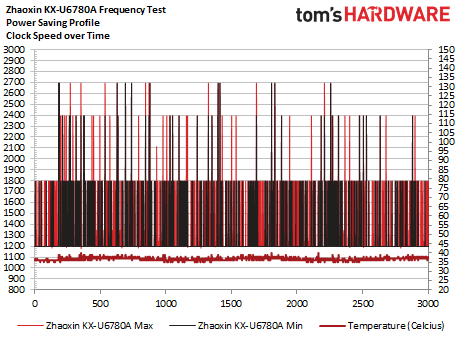
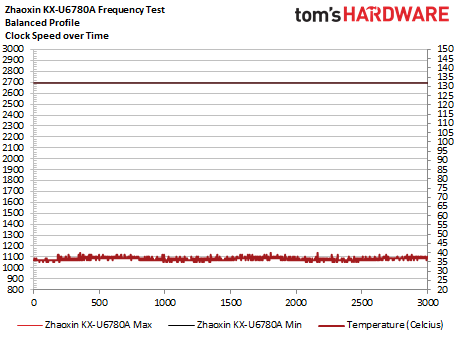
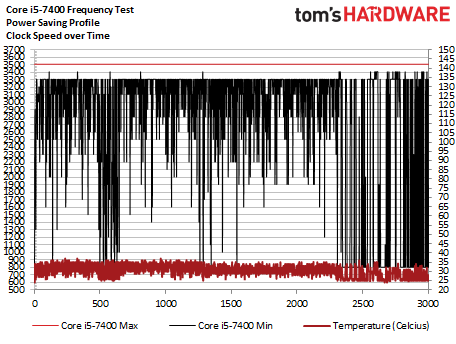
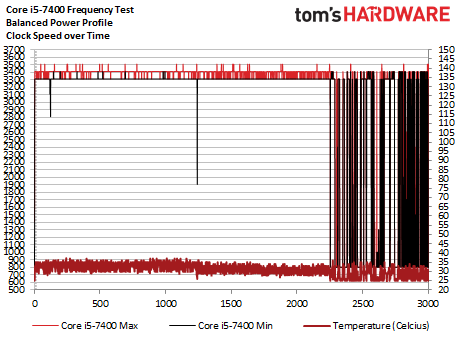
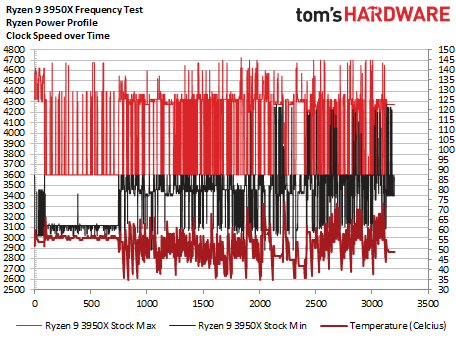
The chips are somewhat rudimentary in regards to two key technologies: Boost frequencies and simultaneous multi-threading (SMT). Unlike Intel and AMD, the KX-6000 chips have no SMT/Hyper-Threading, which leaves some performance on the table in threaded workloads. The chips also don't have boost capabilities, so if you select the Windows high-power or balanced power profile they operate at 2.7 GHz regardless of workload, electrical, or thermal conditions (aside from a normal temperature throttling mechanism for self-protection). That means better cooling will not unlock higher performance, and overclocking is also not on the menu.
Using the power saving feature does enable P-State transitions as shown in our boost testing above, but this is designed more for power saving as opposed to extending performance beyond the 70W power budget. Interestingly, the first-gen ZX-C chips did have boost capabilities, but this feature was apparently deprecated in newer versions of the architecture. This obviously has performance implications in lightly-threaded applications. The chip also supports C1-C4 C-States.
Zhaoxin lists the chip with dual-channel DDR4-2666 support (no ECC), but our spartan development board doesn't allow manipulation of the memory frequency and timings, and it doesn't support XMP profiles. Those options might be enabled in shipping systems, but for now, the board merely uses the default SPD profile. That means you'll have to buy a pricey kit with a tailored profile for higher frequencies. Zhaoxin says it expects the chip to support DDR4-3200 in the future, but that is still under development.
The processor exposes 16 lanes of PCIe 3.0 and has an integrated graphics engine with an undisclosed architecture (thought to be based on IP from VIA's partner, S3 Graphics) [EDIT: Zhaoxin later clarified that the graphics are a proprietary solution]. We do know it supports DX11, OpenCL 1.1, and OpenGL 3.2 and features hardware-accelerated video encoding and decoding, but details are scarce and GPU monitoring applications can't scrape any further details on the architectural components. The integrated graphics support DisplayPort, eDP, HDMI and VGA interfaces and can simultaneously output to two screens at a 4K resolution.
| Dota 2 (Lowest fidelity settings) | 1280x720 | 1920x1080 |
|---|---|---|
| Zhaoxin KX-U6780A DDR4-2133 (HP Driver) | 19 fps | 17 fps |
| Zhaoxin KX-U6780A DDR4-2666 (HP Driver) | 20.6 fps | 17 fps |
| Core i5-7400 (UHD 630) | 104.9 fps | 85 fps |
Zhaoxin instructed us to use the default Windows 10 display drivers for the best performance, which yielded 15 fps in DOTA 2 at 1280x720 with the lowest quality settings. We also found HP's Zhaoxin Graphics DCH driver for the chip and gave it a spin. HP's driver is meant for the Windows 10 China Government Edition that is designed to meet the country's security and privacy standards (Microsoft basically stripped out all of its spyware for this special version of Windows for the Chinese government, and we don't have access to a copy).
The driver installed fine on our Windows 10 Pro test image, resulting in the performance listed in the table above. We tested with both DDR4-2133 and DDR4-2666, but increased memory throughput didn't yield big performance improvements like we typically see with Intel and AMD iGPUs. The ~1.6 fps gain at 1280x720 and lack of improvement at 1920x1080 implies that the bottleneck lays elsewhere. In either case, these performance metrics significantly lag the Core i5-7400's UHD Graphics 630 engine that is largely considered useless for meaningful gaming. You're still best served going with AMD for integrated graphics performance.
Dota 2 also loaded extremely slow on the Zhaoxin test system and was generally unresponsive for portions of our test run. As such, you'll need to pair the KX-U6780A with a discrete GPU for a decent gaming experience, not to mention to gain access to DX12 support. We have plenty of discrete GPU testing on the following pages.
The processor supports Linux, Windows 10, and China's homemade "domestic operating system." China also has strict encryption technology requirements for domestically designed and produced chips, which consist of its own SM3 and SM4 encryption hashing functions (based on elliptic curves cryptography) defined by the Chinese National Standard. This is a similar implementation to the encryption used in the modified AMD EPYC designs that comprise the Hygon line of processors, with the obvious intention of avoiding prying western eyes through potentially backdoored encryption algorithms. The China Internet Network Information Center claims SM3 offers similar security and efficiency to SHA-256, while SM4 is similar to AES-128. The chips also support SHA-1 and SHA-256.
On the security vulnerability front, the chips do require mitigations for Spectre Variant 2 but do not suffer from Meltdown. Zhaoxin is integrating in-silicon fixes for Spectre v2 in future architectures. We don't know the company's status on the laundry list of other mitigations that target processors with speculative execution features.
Zhaoxin hasn't specified pricing for the KX-U6780A, though we have already seen systems on the market. Given the lack of pricing, and the fact that we're testing with a development board instead of a shipping motherboard, consider this a performance preview.
With those details out of the way, let's take a closer look.
MORE: Best CPUs
MORE: CPU Benchmarks Hierarchy
MORE: All CPUs Content
Current page: From China, With Love
Next Page Zhaoxin IPC, Performance Scaling, and Power Consumption
Paul Alcorn is the Editor-in-Chief for Tom's Hardware US. He also writes news and reviews on CPUs, storage, and enterprise hardware.
-
nofanneeded China CPU making Potential is in the ARM not the X86 market ... their Huwawei Kirin ARM CPU is the thing not X86 Chips.Reply -
alextheblue Replywe're looking at roughly the same power draw, if not slightly less, than AMD's A10-9700 that's also fabbed on a 28nm process.
It seems you're implying both chips are fabbed on the same process. The first page says 16nm FinFET.
Even with the somewhat unclear power results, we can clearly see the power burden bestowed by the older 28nm process. -
Paul Alcorn Replyalextheblue said:It seems you're implying both chips are fabbed on the same process. The first page says 16nm FinFET.
Good eye, thanks Alex. Fixed. -
jimmysmitty ReplyRemember AMD's Phoenix-like rise from the relative ashes of the semiconductor market to the value and performance leader?
I do. It only took one daring new architecture with a massive 52% IPC gain paired with a good-enough 14nm GlobalFoundries process, and perhaps a little bit of luck with Intel's delays on the 10nm node, to upset both the desktop PC and data center markets.
Except AMD already had what they needed to meet Intel performance wise and their first step was a catch up after using a uArch that was just bad all around. Bulldozer launched to being beaten by K10.5 CPUs in some areas.
You also have to consider that Intel and AMD had a big settlement a few years ago that allowed for cross patent sharing so AMD has a lot to work with to design.
This CPU is extremely underwhelming and will probably only exist in the Chinese market or places that are too cheap to buy AMD or Intel. -
JarredWaltonGPU Reply
Zhaoxin is at least capable of making x86-64 CPUs, and there's been a pretty decent uplift in performance over its previous gen chip. Still a long way to go, sure, but I don't think closing the uarch gap is going to be that difficult -- especially if patents and licensing are ignored. I'm sure these chips violate hundreds of Intel and AMD patents, but proving that will be difficult, and as long as they remain a China-only product there's not much to be gained by AMD or Intel in trying to fight it.jimmysmitty said:Except AMD already had what they needed to meet Intel performance wise and their first step was a catch up after using a uArch that was just bad all around. Bulldozer launched to being beaten by K10.5 CPUs in some areas.
You also have to consider that Intel and AMD had a big settlement a few years ago that allowed for cross patent sharing so AMD has a lot to work with to design.
This CPU is extremely underwhelming and will probably only exist in the Chinese market or places that are too cheap to buy AMD or Intel. -
Dsplover What a kind review for a crappy chip.Reply
Can’t wait to see the excitement over the next major achievement... -
pug_s ReplyJarredWaltonGPU said:Zhaoxin is at least capable of making x86-64 CPUs, and there's been a pretty decent uplift in performance over its previous gen chip. Still a long way to go, sure, but I don't think closing the uarch gap is going to be that difficult -- especially if patents and licensing are ignored. I'm sure these chips violate hundreds of Intel and AMD patents, but proving that will be difficult, and as long as they remain a China-only product there's not much to be gained by AMD or Intel in trying to fight it.
Zhaoxin exist only because China's contingency plans if they are not allowed to buy intel or AMD desktop processors. Thanks to Obama's and Trump's exclusion to buy US technologies, China's 2025 plans is to get away from US technologies in the next few years. In the next few years, the Chinese government will probably use some kind of Linux dist using Risc V chips utilizing open source software. -
Gurg For reference, performance in Fire Strike Physics is about 87% of the 7857 score generated by my old 2700K eight years ago.Reply -
jimmysmitty ReplyJarredWaltonGPU said:Zhaoxin is at least capable of making x86-64 CPUs, and there's been a pretty decent uplift in performance over its previous gen chip. Still a long way to go, sure, but I don't think closing the uarch gap is going to be that difficult -- especially if patents and licensing are ignored. I'm sure these chips violate hundreds of Intel and AMD patents, but proving that will be difficult, and as long as they remain a China-only product there's not much to be gained by AMD or Intel in trying to fight it.
It's an extremely long way to go. Its using more power and in a lot of cases giving half the performance of an i3.
I don't see AMD or Intel fighting it but still even in China this will only sell well to basic users if that unless the government limits or stops sales from AMD and Intel. No one wants to pay money for a product thats that far behind.
